Pearl Lemon Cafe: Coffee Shop Case Study
The Pearl Lemon Catering team’s first major project was our first cafe – building and designing Pearl Lemon Cafe (located in Fulham). This cafe had to be built 100% from scratch. This would include legal forms, finding contractors, designing menus and the shop, marketing and more. And that is what makes this the perfect example for a coffee shop case study.
As our first ever cafe build, there was plenty of learning opportunities along the way with things both done very right and with room to improve- making Pearl Lemon Cafe the best team that could help with a coffee consulting project; we have seen it all and then some.
The owners were from the UK (Deepak) and Southern France (Axel). Their goal was to have a lemon-based theme, especially colour-wise, pictures, and dispensers to fit the overall Pearl Lemon brand image.
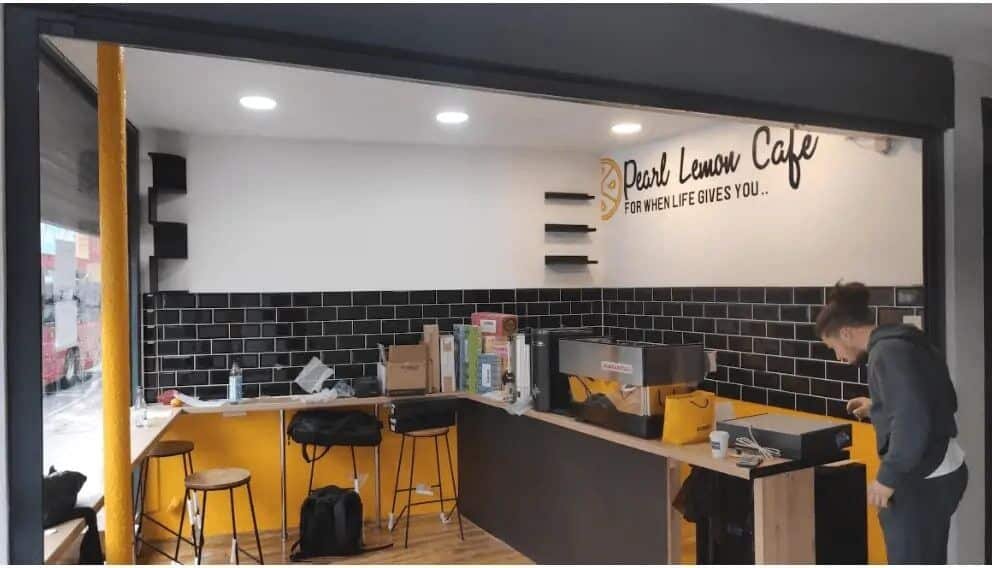
The Scope of Work
With a budget of £27,000, the Pearl Lemon Cafe project had to be done affordably but as high-end as possible. This cost would include designing the cafe and purchasing equipment and initial supplies.
The cafe’s vision was to embody the vibrant lemon yellow hue of Pearl Lemon while creating a versatile space where people could work, relax, or grab a quick coffee. Deepak, having been a fully remote worker for many years, was instrumental in shaping this vision based on his extensive experience.
Having spent countless hours working in various settings, from bustling chains like McDonald’s, Costa, and Starbucks, to the quieter ambiances of hotel lounges, Deepak had a clear idea of what elements were essential for the perfect cafe environment. He knew precisely what he wanted to incorporate and what pitfalls to avoid. His experiences had shown him the importance of comfortable seating, ample lighting, reliable Wi-Fi, and a conducive atmosphere that could accommodate quick visits and long hours of productive work.
Deepak’s insights were crucial in designing a cafe that was aesthetically pleasing with its bright, inviting colour scheme and functionally tailored to the needs of diverse patrons. This attention to detail ensured that the cafe would serve as a prime destination for those looking to enjoy quality coffee in a space catering to relaxation and productivity.
The fundamental idea is it’s a reflection of the Pearl Lemon company ethos >
Young, vibrant, energetic, and full of energy and life.
This coffee shop project included the following:
- Finding a location
- Negotiating rental price
- Getting the team their level 3 and level 2 food safety & hygiene certifications
- Getting the food hygiene rating
- Applying for a food business to be registered in Fulham
- Getting insurance
- Getting various licenses and relationships built (waste, internet, etc.)
- Setting up supplier relationships
- Placing initial orders
- Equipment research and ordering
- Finding contractors to paint and help make the space pretty
- Getting pavement licenses
- Getting alcohol licenses
- Marketing
- Delivery platform set-up
- And more…
Costing the Ingredients and Equipment
Finding our equipment and ingredient suppliers was one of the more difficult parts of the initial coffee business setup. This involved extensive research to find the best products at the best price to avoid burning through the budget too fast.
As Pearl Lemon Cafe evolved, we went through 4 suppliers before we found the best fit for us. This meant coffee beans, takeaway items, and pastries. As we approached our 1-year mark, this happened again to find who aligned the best with us as a coffee business.
We formed a great relationship with our Mazarcco supplier to get other grinders and machines for catering events and a coffee supplier that could deliver at the last minute or the next day in case of emergencies.
Part of finding a coffee supplier also included someone who would help us with white labelling (like the nifty coffee bag to the right of this text) so we could sell our coffee in the shops and on our Shopify site. (We will talk about Shopify later)

The Design
So, having had several conversations with the proposed contractor (who built several cafes along North End Road) – we’ve got the basic framework for what the layout might look like:
The coffee shop design to the right, designed by a member of the team, is frankly amazing and represents a vision of how the cafe will look once it’s up and running.
Basic themes and concepts are:
- Plants – everywhere, on the shelves, on the ceiling in hangers, everywhere there could be a plan we wanted it
- Lemons
- Clean/open space (as much as the tiny unit allows)
And then build from there.
Finding decor to fit this vision was a fun challenge. We found mini lemon bowls to place throughout the cafe. We got fake lemons to draw faces on to place around the register. We also invested in a motorbike for photo ops in the cafe.
In the spirit of photo ops, we also got an Instax mini camera to take instant Polaroid photos to display in the cafe.
This was all a part of the vision for the coffee shop design.

Coffee Sourcing
The mission was clear: to offer the finest cup of espresso or coffee in Fulham and potentially all of London. For Dee and Axel, this was not just a goal but a commitment to luxury and quality that required meticulous effort and dedication.
The process was intensive and thorough, with Dee and Axel spending about a month visiting three different roasteries each week. This wasn’t just about tasting different roasts; it was about understanding the entire coffee-making process from bean to cup. They were particularly vigilant about avoiding any roasts that yielded an acidic or burnt flavour, which are common critiques of some mainstream chains.
Beyond the flavour, the ethical sourcing of the coffee was paramount. They sought out coffee that was not only organic but also certified as bird-safe and rainforest-safe. Additionally, the coffee needed to be fair trade and fully traceable, ensuring that every cup served was not only of the highest quality but also ethically produced.
This rigorous selection process ensured that the coffee offered at the cafe would not only delight the palate with its luxurious taste but also resonate with customers who valued sustainability and ethical practices. Dee and Axel’s dedication meant that every aspect of the coffee’s production aligned with Pearl Lemon’s values of transparency and pride in their offerings.
Good for us, good for you and good for the environment.
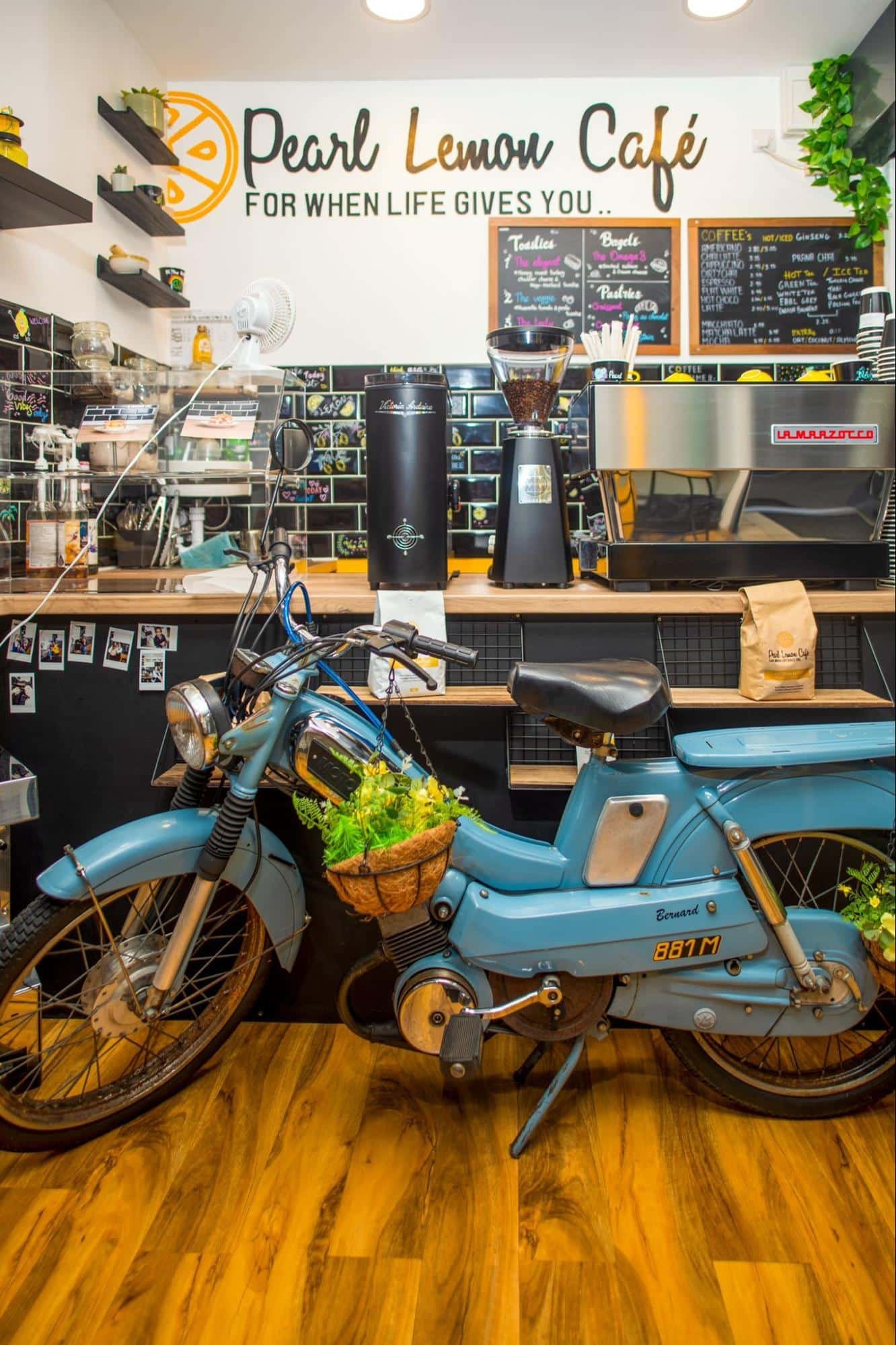
After a comprehensive search and tasting, we partnered with a roastery willing to offer white-label services, allowing us to sell our favourite blend under our own brand. This blend, which quickly became a favourite, boasted flavour notes of black cherries and chocolate, providing a rich and smooth finish that our customers loved. These beans, sourced from the Jinotega region in Nicaragua, were of the Catuai and Caturra varieties, grown at an altitude of 1300 meters above s
With the coffee beans selected, the next critical step was choosing the right equipment to bring out the best in our chosen blend. After weeks of meticulous research, demonstrations, and consideration of various options, we settled on a Mazarcco espresso machine. Renowned for its durability and precision, the Mazarcco machine was chosen not only for its consistent ability to produce exceptional espresso but also for its reputation and recognition among coffee industry experts. This investment was seen as essential for ensuring that each cup of coffee we served was crafted to meet our patrons’ high expectations and maintain the luxurious coffee experience we promised.
This careful selection of our coffee blend and equipment solidified our commitment to offering a top-tier coffee experience, making our cafe a destination for coffee enthusiasts seeking quality and consistency in every cup.
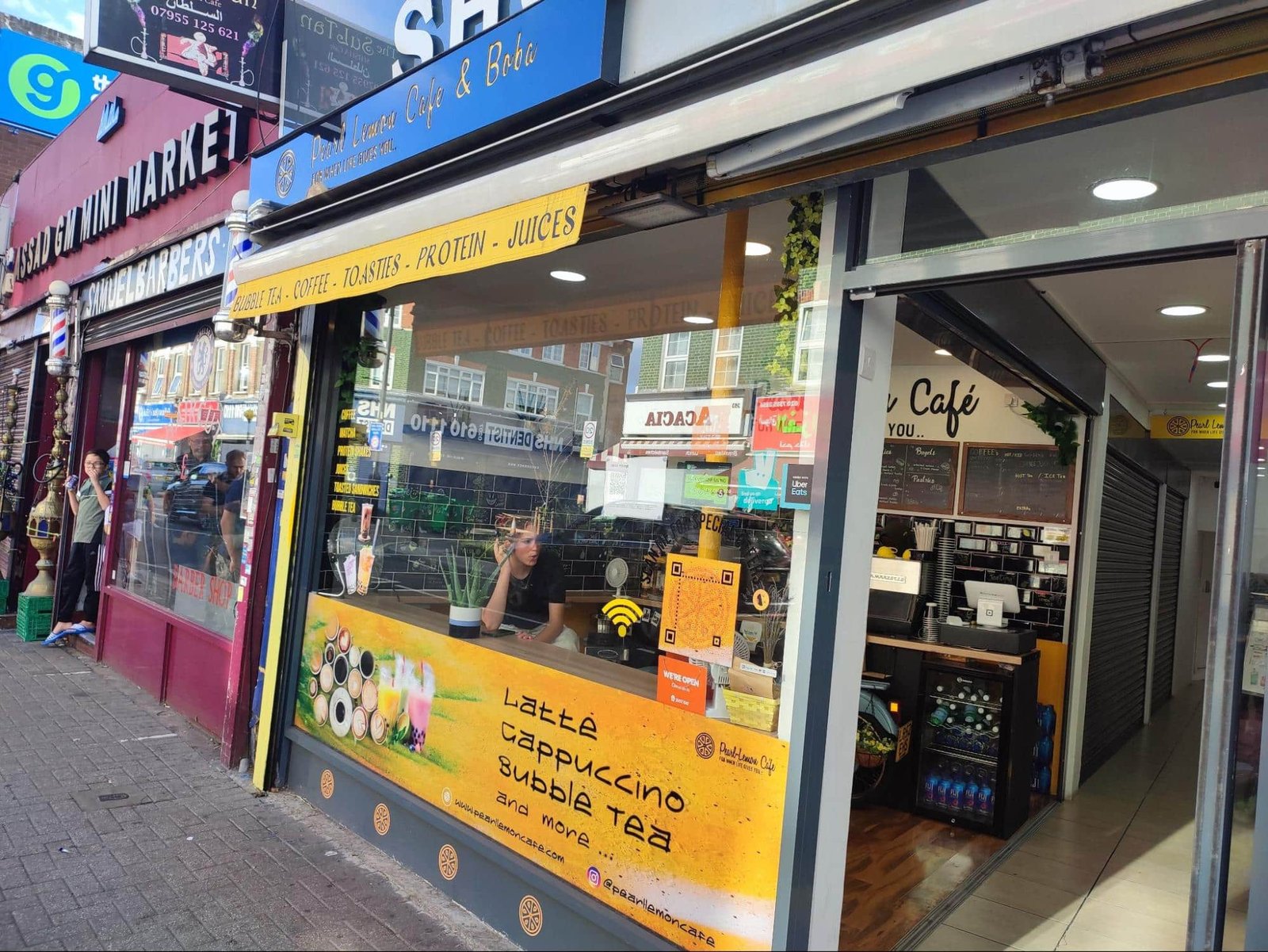
Designing the Menu
Designing our menu was one of the most fun parts of the coffee shop’s build, design, and overall setup.
We wanted something classic and familiar but a few unique offerings that would set us apart. We relied heavily upon Axel’s experience being from Southern France. He specialised in taking his experience and looking at what was missing from the local market to have us stand apart and above the crowd.
Menu design also included looking at local produce and shops to push affordability and sustainability and support local.
First things first: our coffee drinks. We wanted to include all the classics (latte, cappuccino, hot chocolate, espresso, Americano, etc.).
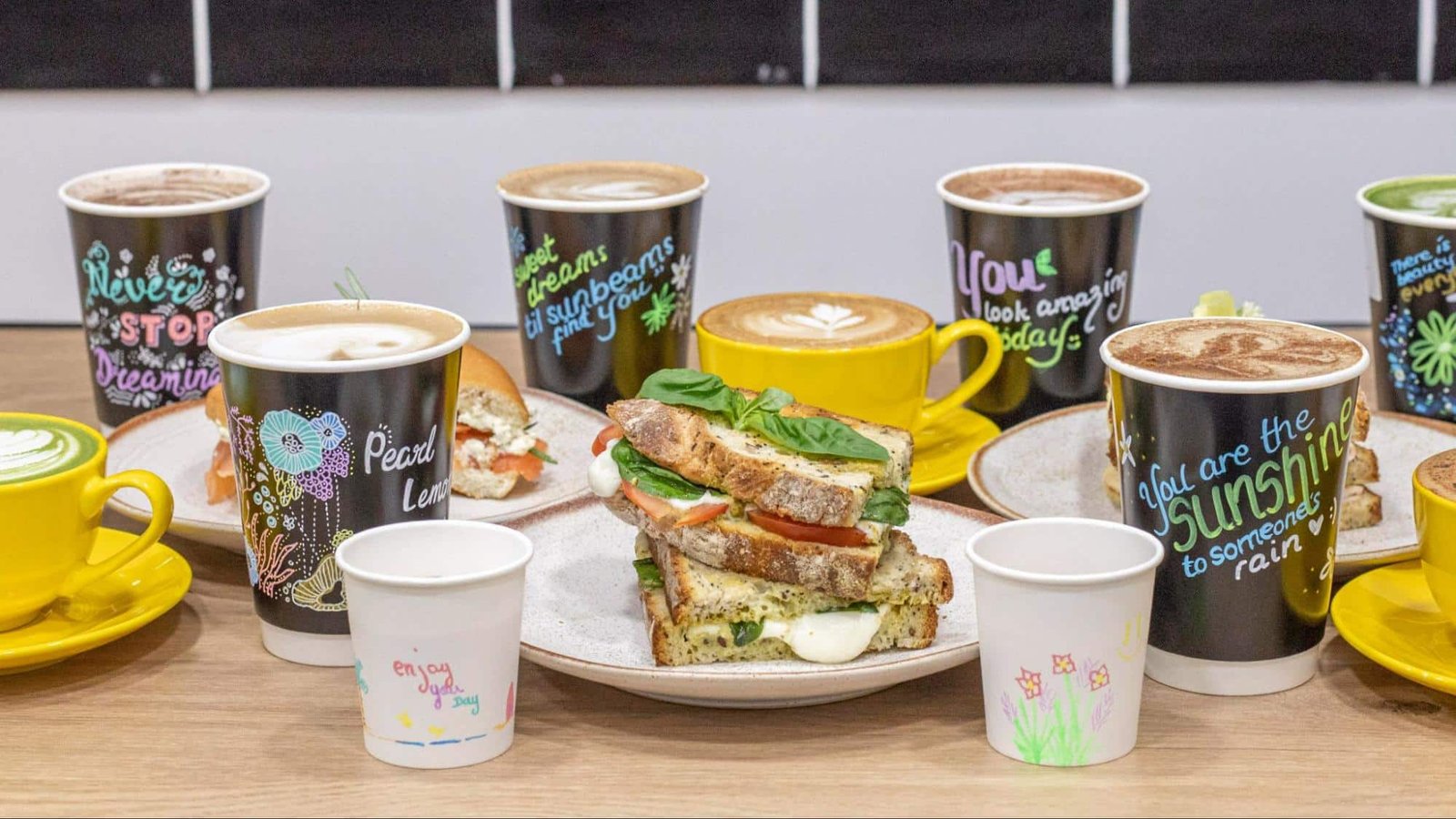
But we opted for a few unique drinks, namely ginseng coffee.
Part of the coffee menu design also included focusing on quality. Because you can get a latte anywhere, we wanted it to be the best latte you could find. We spent days training the team to help them learn how to achieve the perfect steamed milk to put into an espresso drink, how to perfectly time the espresso being pulled, and when to add milk. Based on our reviews, it worked.
We also had to add milk alternatives. So, in addition to the standard skim milk and 2%, we opted for oat, soy, coconut, and almond milk. This was to keep the menu allergen-friendly and more inclusive. We also didn’t charge extra for milk alternatives like most other shops.
Even though some shops charge an extra .50 per cup, we felt it would be better to include it in the price. This way, no customer felt taxed due to an allergy or intolerance. This also leads to alot of happy people.
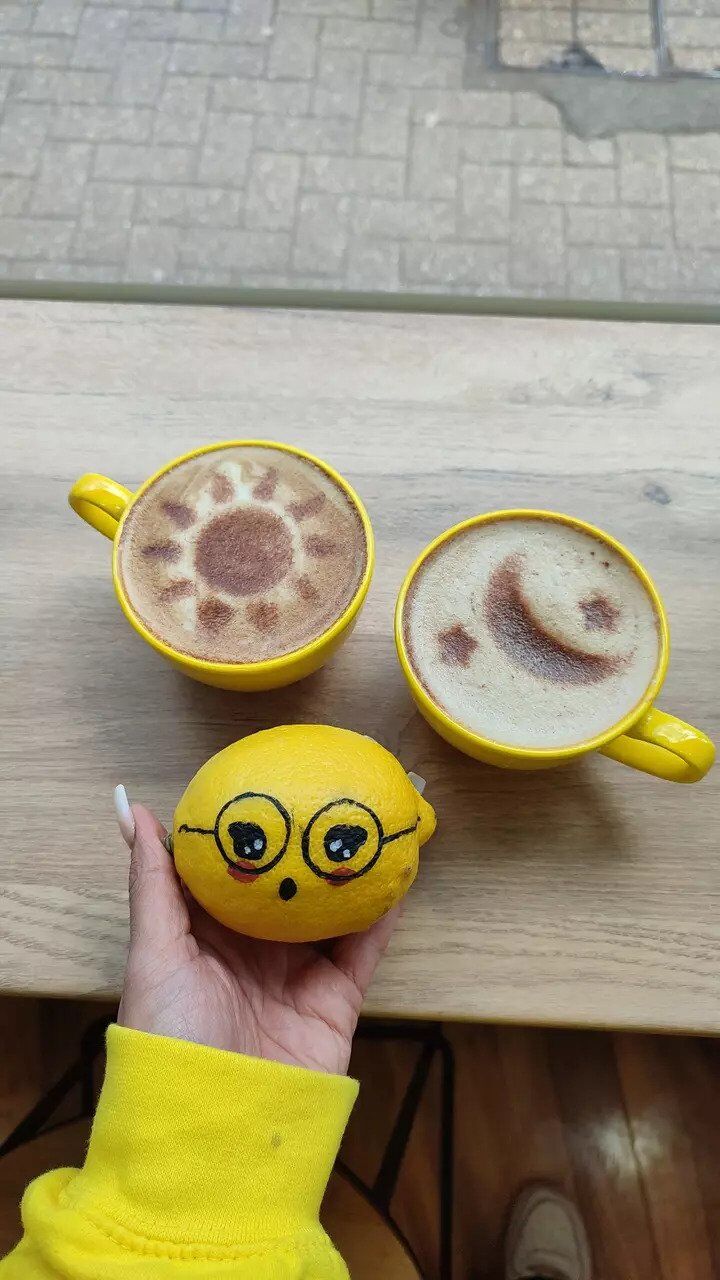
In addition to crafting the perfect cup of coffee, our menu at the cafe also featured an array of toasties and pastries, each designed to complement the coffee experience and cater to diverse customer preferences. Pastries are almost a universal favorite in cafes, offering a sweet complement to the robust flavors of coffee. Therefore, our selection included cinnamon rolls, sacristans, croissants, and homemade banana bread, with the banana bread quickly rising to become a top seller, beloved for its moist texture and rich flavour.
Understanding the diverse needs of our customers throughout the day, we introduced a carefully curated selection of toasties aimed at attracting not just the morning coffee crowd but also those seeking a hearty lunch or a fulfilling afternoon snack. Our menu featured four signature toasties, each crafted with a unique combination of ingredients to appeal to a variety of tastes:
- The Tasty – A classic option filled with high-quality cured meats, a blend of cheeses, and a touch of homemade sauce for those craving a savoury, indulgent meal.
- The Elegante – Aimed at more refined palates, this toastie includes gourmet ingredients such as brie, fig jam, and arugula, offering a sophisticated flavour profile.
- The Omega – Packed with nutrients and flavours, this option features smoked salmon, cream cheese, and capers, catering to health-conscious customers looking for a protein-rich meal.
- The Veggie—This delight for vegetarians is packed with fresh seasonal vegetables, pesto, and a vegan cheese option, ensuring that everyone has a tasty and satisfying choice.
These offerings were designed to satisfy hunger and enhance the cafe experience, encouraging customers to linger over their meals and enjoy the welcoming atmosphere. By providing various savory and sweet options, we aim to establish the cafe as a versatile destination that is perfect for any time of day and culinary preference.
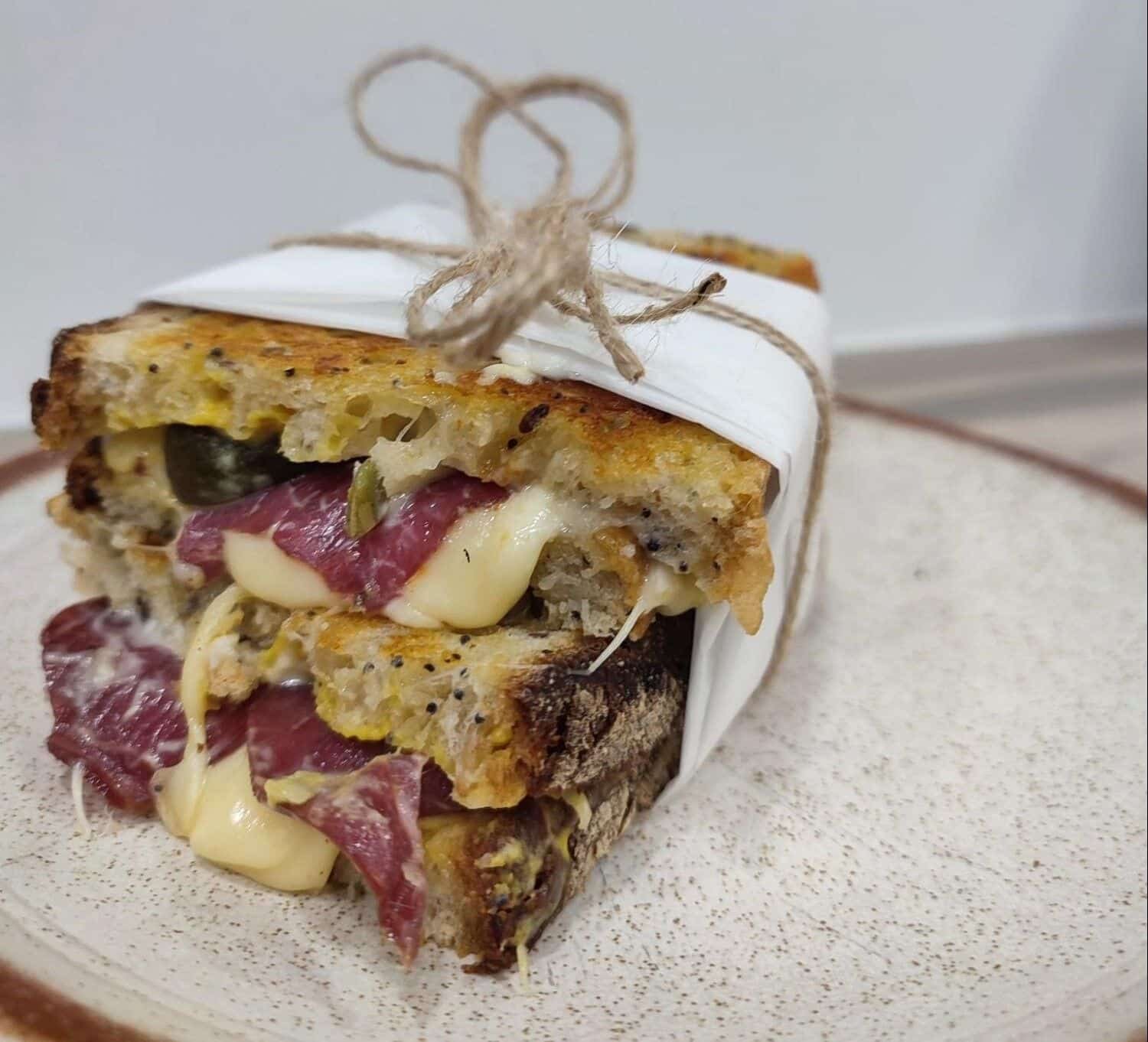
Progress
First, while our Procurement Director was sourcing items for the cafe INSIDE, we got contractors to start on the coffee shop design.
The flooring was put in, the walls painted, and the shelves put up. We tried to stay as local as possible- going to Ikea for alot of the internal items and other local shops. Outside, the shutter was painted, and banners were put up. We had a local artist take care of our shutters outside- he was great. He worked fast, and in the end, it looked amazing.

Ultimately, we got a beautifully designed cafe with bright yellow that stood out from the rest of the street.
Meanwhile, back on the operations side of set-up was hiring and buying.
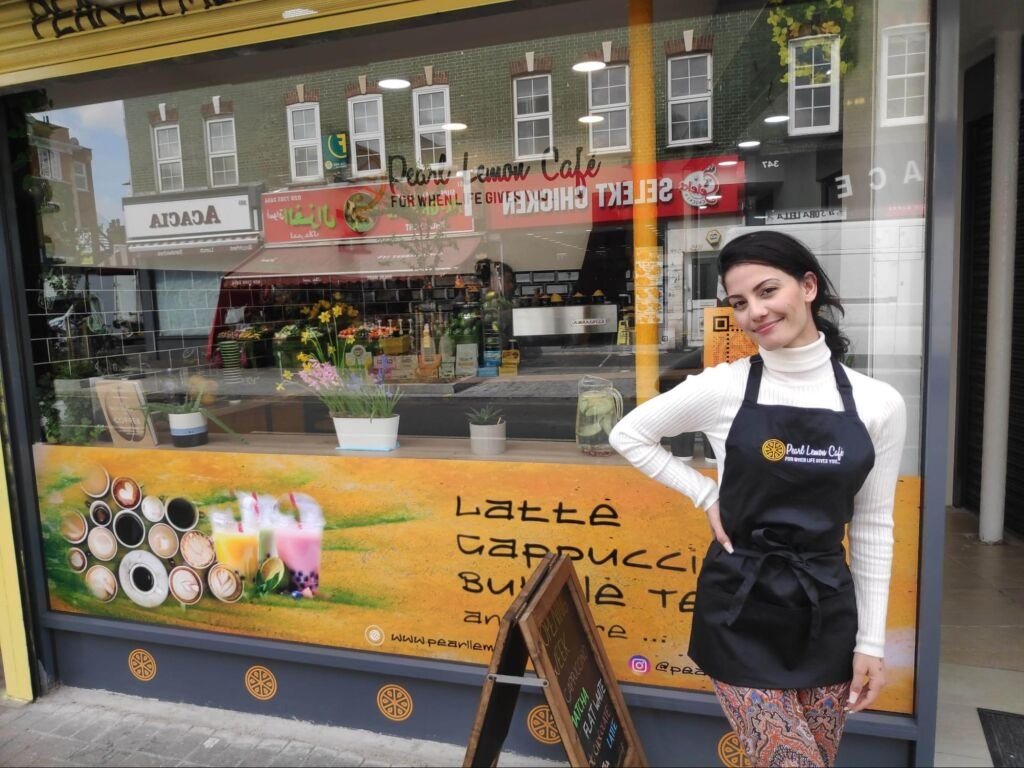
Hiring and Training
To ensure our cafe team was fully equipped to deliver an exceptional customer experience, we developed comprehensive video training modules. These videos were designed to teach them not only the practical skills needed for making drinks, including latte art, but also the nuances of serving both take-out customers and those who chose to stay in the cafe. A significant emphasis was placed on customer service excellence, covering essential skills such as engaging with customers, encouraging reviews, and enhancing their overall approachability and cheerfulness.
The training videos also provided detailed tutorials on all our recipes, ensuring that written and visual learning preferences were accommodated. This approach guaranteed that every team member, regardless of their learning style, had the resources to master their roles, aiming to cultivate a team that exemplified the best in the industry.
Once our team was expertly trained and ready, the next step was to outfit them appropriately. This involved sourcing suppliers for uniforms, designing logos, and conducting mock-ups before finalizing the orders. We opted for sleek, solid black t-shirts with a subtle logo, complemented by aprons and button-up black shirts, which projected a professional and cohesive image together.
Below is a photo of one of our core team members proudly wearing the apron in front of the cafe, embodying the spirit and professionalism we strive for at our establishment.
In addition to preparing our team and their uniforms, we also needed to select the optimal Point of Sale (POS) system to streamline our operations. After evaluating nearly ten suppliers and participating in various product demonstrations, we partnered with Square. We chose Square because its platform is not only secure and user-friendly but also offers the flexibility to make adjustments as needed easily. Moreover, their reasonably priced equipment bundles made them an economically viable choice, ensuring we could maintain cost-effectiveness while providing top-notch service. This comprehensive setup, from training to technology, ensured that we were well-prepared to meet the needs of our customers and deliver a memorable cafe experience.
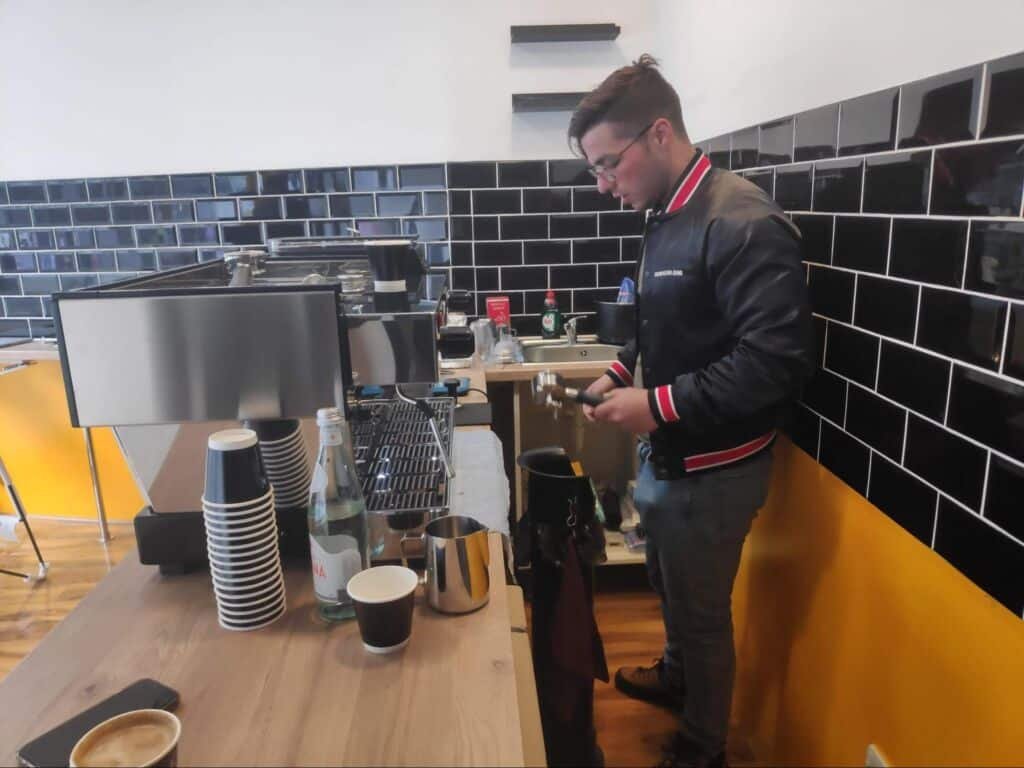
The Legal Stuff
Legal “stuff” was a long, detailed process. It was mission-critical not to miss anything to avoid delays in our grand opening or risking the potential of being shut down.
The first was applying for a food license. This meant:
- At least one person needed a level 3 food hygiene certification (this took 5 hours per person) A Manager needs to have level 3, but the rest of the staff don’t technically need one as its assumed they are taught. We ended up having two level 3s and 5 level 2s on staff because we wanted to be bulletproof.
- We needed to have public liability insurance (this meant hunting and getting quotes) We had a tough time with this as we did catering as well, so we needed close to 1 million in coverage for public liability due to serving food.
- We had to build a fire safety analysis (to prove we were safe). This was a surprisingly tough document to build as we had to show that everything was up to code and that everything was fully mapped out.
- We had to build a HACCP (this over 50-page document was built to show we can handle any issue or potential hazard, from mould to spoilage to fire or flood). This took close to a week to fully build, and that was with a template guiding us. If there could be a contaminant, we had to list what it was, how it could happen, and how to prove and handle the situation—from chemicals to glass to illness and everything in between.
- Prove we have a waste and rubbish contract. This was simple and most of the time was spent finding the best price for the best service.

While that is just five core items, it took nearly a week to get together and apply. It was a lengthy process.
Other legal items that came next were registering our logo as a trademark so no one could pretend to be us, going through alcohol license courses and tests (this one was another two-week process) and getting a premises license to serve alcohol.
Setting up Pearl Lemon Cafe on delivery platforms was a key part of our marketing strategy. As a new business, we couldn’t solely rely on foot traffic to bring people in. This meant relying on delivery platforms to get us visibility online.
Our first choice was Deliveroo, then Uber Eats and Just Eats.
The initial setup had challenges, but it was duplicated once we figured out one.
Each had an initial application to fill in with general questions like name, contact information and restaurant information. But then came the long part- we had to turn our menu into a spreadsheet to show price, description, item name and any modifiers. That took a few days to build, BUT once it was done, it was done.
This was then sent as a package to each respective account manager assigned to us.
Delivery Platforms
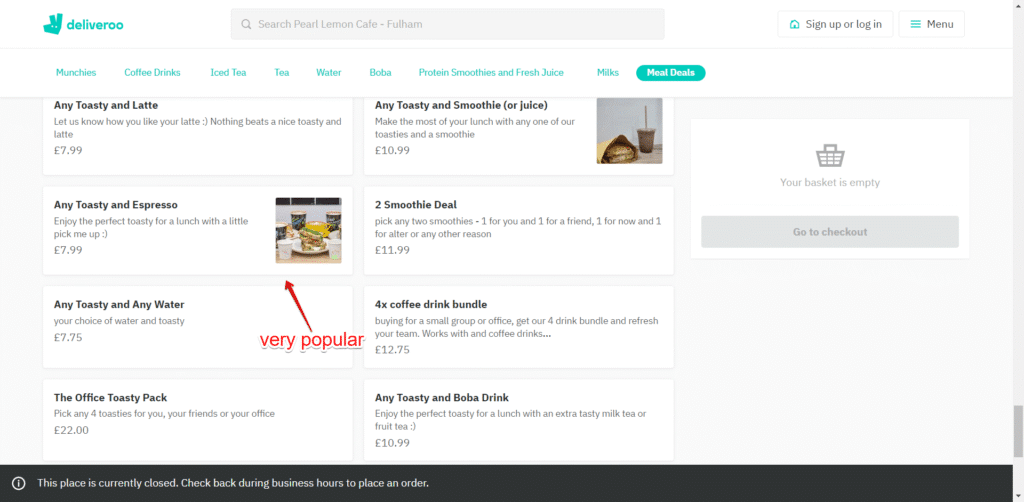
Delivery platforms maintained an ongoing project through year one- experimenting with ads and offers, changing descriptions and photos, and making bundle deals. We invested much time and energy into this portion of the project to gain as many new and recurring customers as possible.
We found there was a very particular formula to having the perfect restaurant listing on these platforms. We spent 80 hours per platform after going live fine-tuning and developing our “secret sauce”.
Descriptions had to be written in a particular way, pricing had to be set just right, images had to be factored in, reviews had to be included, and more. It was a true challenge.
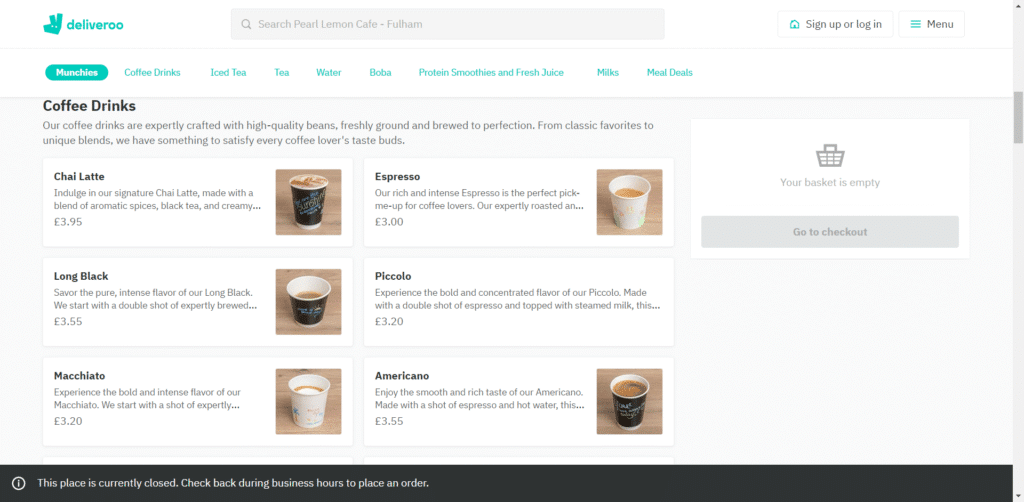
Inventory and Stock Management
One of the biggest research projects we had to undertake was determining what equipment and consumables we needed.
The further we got, the more we realised we needed more.
For example, we knew we needed a mini fridge and ended up ordering 2-3 more. We also knew we needed an ice machine but ended up needing so much more that we had to get one that could go under the counter.
Once we figured out all the large equipment, we went onto the small “here and there” things. This included temp logs, various storage containers, spoons and other washable items for staff to use, backup pumps for syrups and more.
The list ended up feeling endless, but we did it.
From Amazon to Nisbets to Ikea, we got everything we needed to have a fully functioning cafe that kept everything safe at all temperatures and stored safely.
To give you a feel for what we had to purchase:
- Ice maker (initially something small because not many people ever wanted ice)
- Under the counter ice maker (a heatwave hit and our smaller machine could no longer handle what was needed)
- Fridge (all of our milks and one for all of our bottled water)
- Freezer (for ice and longer term storage)
- Blender (for smoothies and blended drinks)
- Cupboards
- Chairs
- Cleaning supplies
- Mop
- Grinder
- Espresso machine
- Square Terminal
- Tablet for square
- A-board for outside (we needed to get those views from the street)
- Sandwich press (because who doesn’t love a hot fresh, toasty)
- And more…way more
Then there was the consumables:
- Starting with supplier relationships (we wanted the best prices so Lydia had to undergo a heavy negotiation process)
- Milk suppliers
- Pastries
- Toasty supplies (meat, bread, cheese and veg)
- To go supplies for sandwiches
- Juices
- Coffee
- Coffee Syrups
- And more
Once we established everything we needed and had. We built a purchasing spreadsheet to start while we honed in on who was best. Choco swooped in to save the day making ordering for us way easier as it put it all in one place- no log ins no spread sheets…no nonsense.
Before the app, Lydia and Axel worked in one giant shared sheet with a check box system. It seemed to be the best way to be cohesive with a 5-hour time gap. Lydia would include all the information needed in the sheet. Such as product name, a description, where it was for, where it was from, the cost and the URL. Axel would then check the sheet when things needed to be ordered, check off a little box and write in how many packs. Lydia would check the sheet at her EOD and order for the next day or within 48 hours. As we got busier and expanded, this became hard to manage and other team members requesting items wouldn’t use the sheet. So choco was a life saver- it is on our recommended list of must-have tools when opening a cafe or restaurant.
The internal team was quick to establish a purchasing protocol with Lydia. After a few weeks of watching inventory, a rhythm was built so that when an item had a week left, Lydia would order it and deliver it in about 72 hours, so there would be no excess stock.
Offline Marketing Efforts
Marketing cannot be forgotten in our cafe’s setup.
We made offline and online efforts to ensure we hit the ground running. Marketing work began before a physical location was found. This was an absolute must to try to out rank the competition as we opened to try to convert as many people to become our loyal customers.
This meant building the website, social media accounts, and directory listings. Once these were built, we began SEO work to increase our visibility on Google and maintain an active online presence.
We also began flyering around Fulham to help gain more local visibility while we went through our online campaign. If we wanted to be seen locally while SEO did its magic, we had to actually be SEEN. This meant flyering in car parks, mailboxes, gyms and bulletin boards. There was a heavy push to write reviews and refer people for discounts.
Aside from flyering, we also bought loyalty cards. Once we got them in we trained our team to push people to take one home with them. They were a simple buy 9 get the 10th free stamp card. This worked phenomenally in creating repeat customers. we had to order over 5000 loyalty cards in year one.
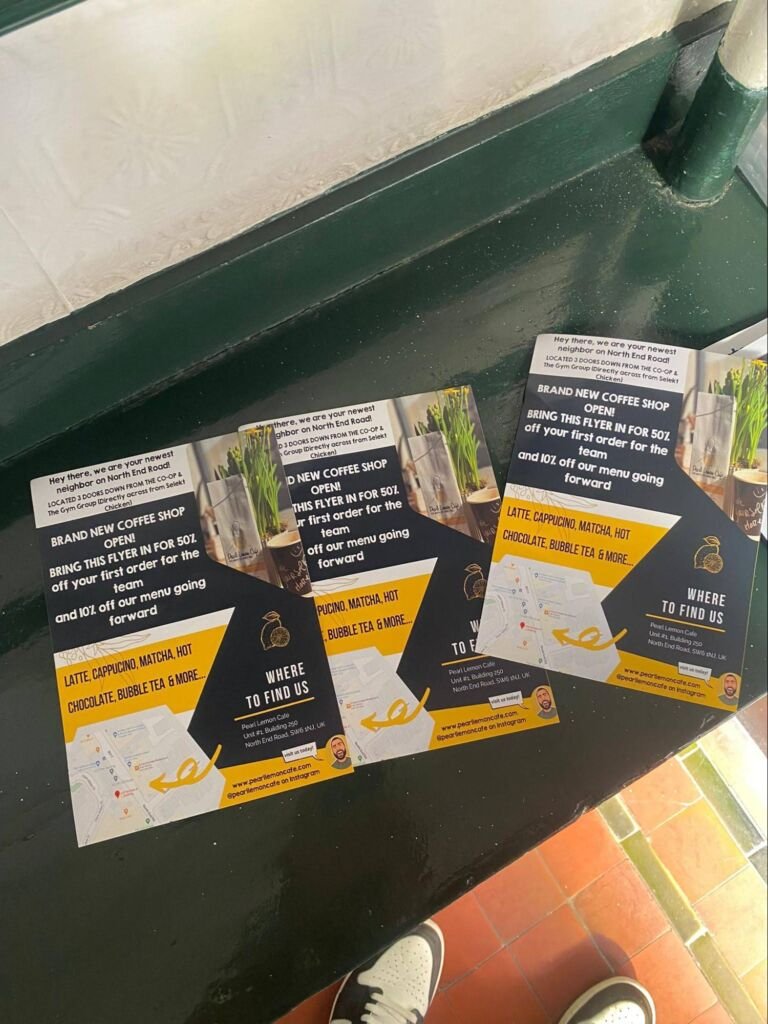
We also had QR codes at the register to scan for discounts and reviews. This was a simple and engaging way to get people to leave reviews while waiting for their drink to be ready.
Pearl Lemon Cafe also placed stickers on the front to advertise milk tea and boba teas as well- this gave us a competitive edge as there was no competition nearby for this drink…this did lead to another location opening as a direct result.
The cross-sell opportunity
Fulham has no shortage of businesses and entrepreneurs – and given Pearl Lemon, as a company builds websites and ranks them on Google, it opens up a real sales opportunity.
This meant identifying such individuals and offering them our services where relevant.
Having spent a lot of time sitting in cafes, you get all sorts of business owners who come in.
Furthermore, this was confirmed by asking a friend at Coffee Underground about how many business owners she sees walk through the doors….
And she said dozens – which validates my plan.
Furthermore, Dee visited the coffee truck on North End Road – Souter Bros. Daniel (one of the two brothers) told us that his brother Stuart was away the last two days because he picked up some graphic design work from truck customers.
And that, in general – their coffee truck had been good for his design business.
Thus, building websites for local businesses is going to be possible.
The health & fitness opportunity
As someone who pays for personal training at the local gym – I’ve built a strong relationship with my trainer and see opportunities here.
Broadly – there isn’t anything serving them through easily accessible protein. Mixing caffeine, protein, matcha, and protein will be a reliable way to attract the gym crowd initially.
Having two products – one for pre-workout and one for post-workout will be an excellent way to get this crowd to Pearl Lemon Cafe.
This is not even considering any food opportunities.
i.e., we can uncover the food needs of gym goers and explore pre-orders for opening a dark kitchen and moving into a food subscription.
To this end, there are countless opportunities for cross-selling.
Even in Coffee Underground, I discovered a store patron who was searching for amazing Matcha and didn’t mind making a trip to Marleybone for it, as she said, ‘I work around there.’
The product opportunity
There are many 6,7, and 8-figure coffee businesses we’ve never heard of out there that have built big businesses by selling their range of coffee beans and paraphernalia.
Looking at the local market, it’s clear from the Souter Bros, Coffee Underground, and several other cafes – that one of the bigger aims of their local ‘in-person’ and ‘in-store’ presence is to sell their coffee beans.
And having done a quick Google – identifying a brand (once we do taste and quality testing) seems straightforward enough:
There’s a big market for this type of model.
And given the Pearl Lemon brand with lemons is relatively strong – this can extend to other products such as cups, t-shirts or otherwise.
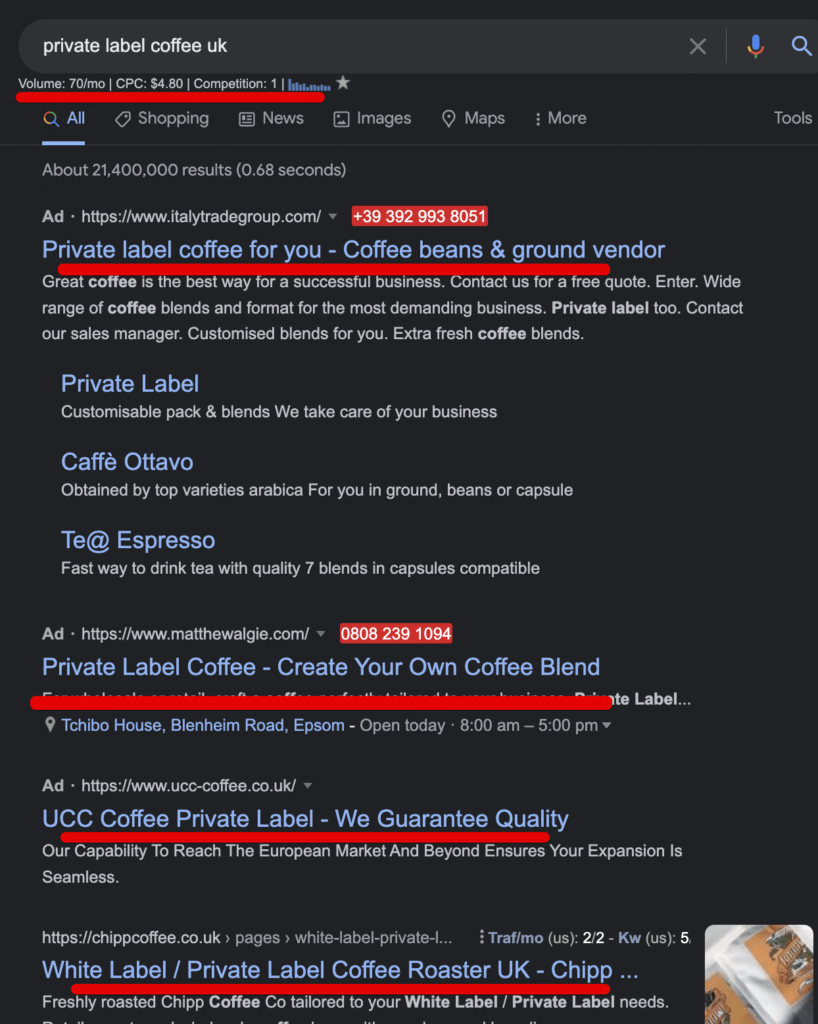
Ranking Locally
We greatly benefited from developing a local marketing matrix to outrank all of our competitors.
One of these strategies we employed was having a beautiful A-board out on the sidewalk for people passing to see on and across the street should they not look up at our sign.
We did extensive research on local businesses and schools and partnered with them for special events. We also launched ourselves on numerous loyalty platforms as well. Having virtual loyalty programs and physical cards allowed us to extend our reach well beyond what anyone else could.
Part of ranking locally was also getting in on associations and clubs because then our name ended up far and wide.
Places like Glassdoor, Next Door, yell, yelp and more allowed us to gain an amazing level of visibility, and we quickly garnered a loyal following.
Local PR was a huge part of this section of our launch as well. We wanted to be as visible as possible. We ended up being published in local newspapers and prints and numerous online publications.
Reviews, Reviews, Reviews
Reviews play a crucial role in the success of any business in the food and beverage industry, where many markets are saturated and competition is fierce. For a new establishment like ours, standing out as the best among numerous cafes, food carts, and bakeries is essential. Leveraging customer reviews effectively is key to solving this challenge, as potential customers often spend considerable time researching before deciding where to dine or order from.
In our strategy to enhance local visibility, we ensured that our cafe was listed on all relevant directories. This placement not only helped potential customers find us when searching for cafes in London and Fulham but also when they looked up our competitors. This strategic visibility was the first step in building our review base.
We actively encouraged our customers to leave reviews by engaging with them directly at the cafe and through follow-up communications. We focused on gathering reviews across multiple platforms, including Facebook, Google My Business, Yell/Yelp, and Trust Pilot. Our efforts were met with great success, as evidenced by hundreds of 5-star reviews that began to populate these sites.
Beyond just collecting reviews, we implemented a meticulous strategy for responding to them. This wasn’t merely about customer service; it was a strategic move to boost our rankings within local search results—an “industry secret” of sorts. By actively engaging with reviews, both positive and negative, we not only showed potential customers that we valued feedback but also signaled to search algorithms that we were an active, responsive business. This approach helped enhance our visibility and reputation, contributing significantly to our local SEO efforts and positioning us favorably in a competitive market.
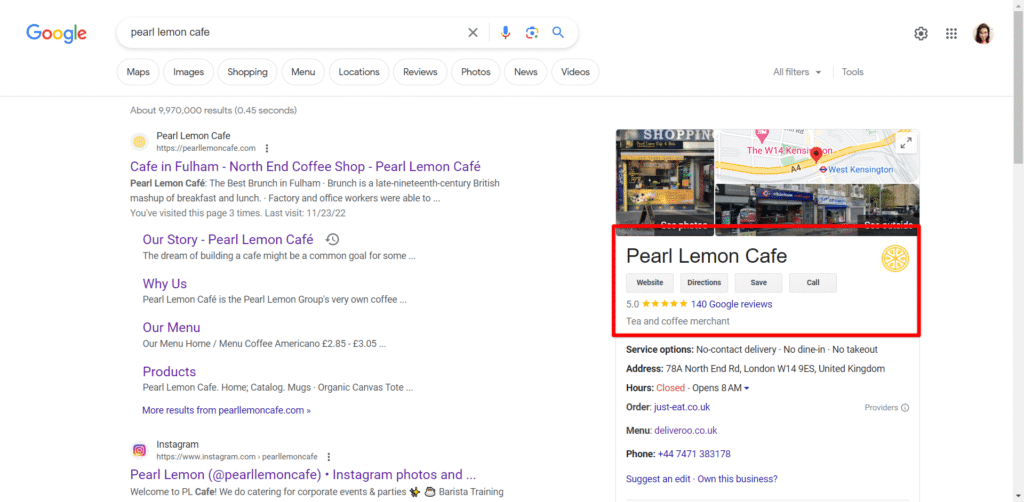
Shopify and E-commerce
Something unique we started to develop early on was our Shopify store. Shop.pearllemoncafe.com was developed to sell our coffee and ship it to customers, as well as other retail items we sold in-store.
There was more than this though. We got our design team heavily involved with Lydia on this project. So, while she spent a week building the website and ensuring the checkout worked and it was functional, the design team started working on a variety of merchandise.
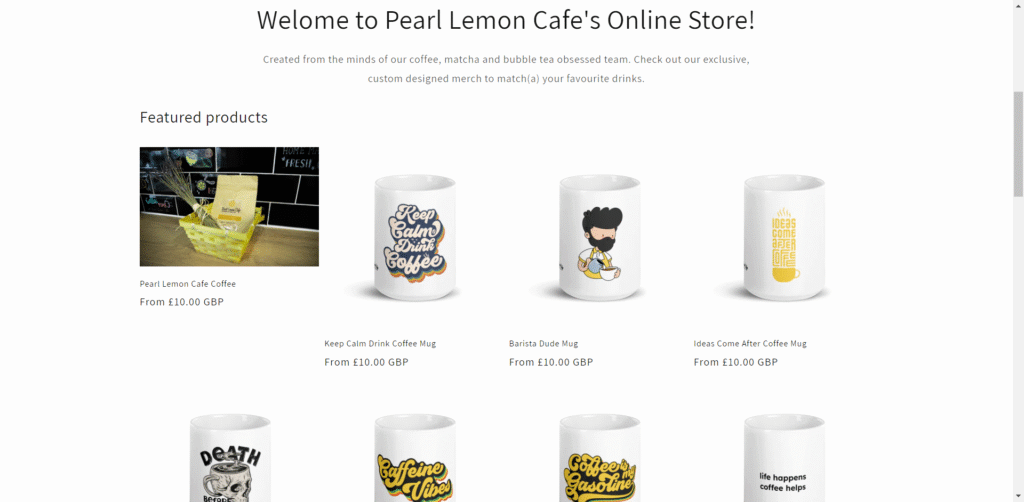
This merchandise was to include t-shirts, tote bags, and mugs. Each “section,” we decided, would have up to 10 different designs or slogans that would be repeated across all item types. This way, if someone really liked “death before decaff,” they could get a mug, tote, and matching t-shirt to fully express their support of caffeine.
Additionally this store was designed to sell any item that could match with our food & beverage locations. This would later include Pearl Lemon Boba and How Matcha.
After a month of designing and a week of website building, the store was ready for orders and was added to our various sites to buy directly from.
We also enjoyed ordering samples and having a fun photo shoot documenting the project.
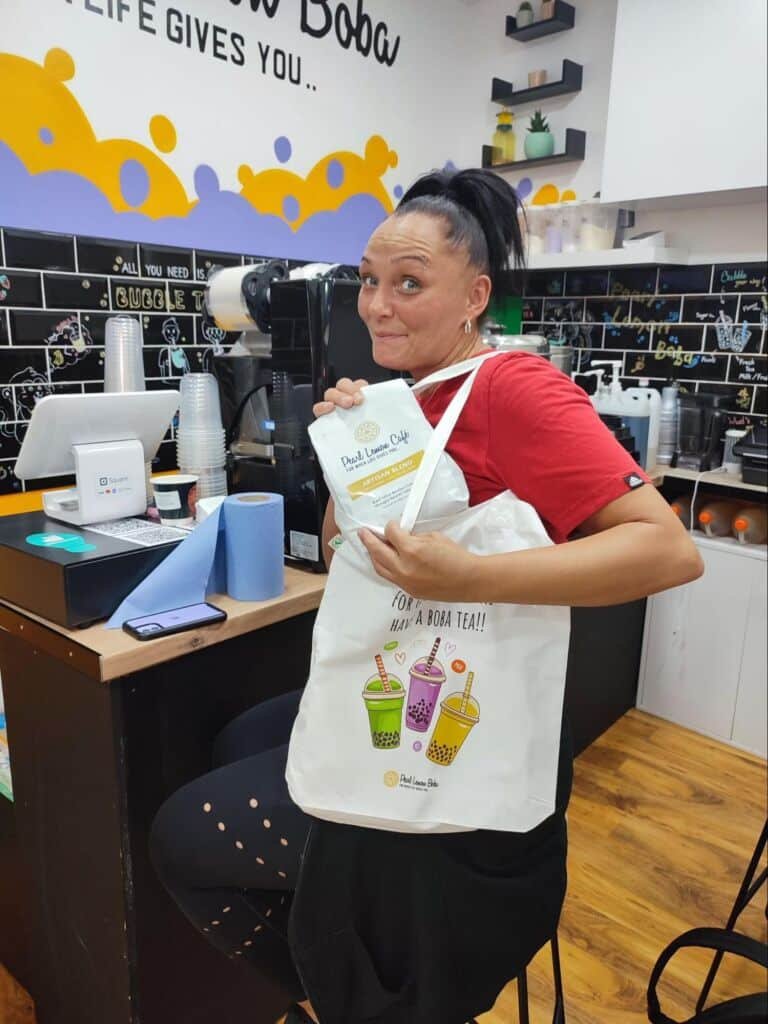
Hurdles and Obstacles
Suppliers and equipment:
This was the biggest obstacle during shop set-up. Large pieces of equipment had to be returned and reordered, leading to delays and temporarily buying stuff locally, like ice.
One supplier, in particular, made support and ordering very difficult when an exchange or service on equipment was needed.
Another supplier made it seem like they were very successful and got great prices for us; two orders later, they were out of business. This caused more than just a few issues as it meant we had to redo our ordering process fully we had in place. We were never able to find a supplier as cheap as them and were never really sure how they could sell so cheap, but it did make our purchases 1.5-2.5 more expensive.
Once we got our ice machine, we also found out we had to hire several builders to make it fit and ensure it worked right. This again meant cutting into shelving, moving equipment around, and troubleshooting the machine. Once in a while, it got a bit fussy.
The heat wave: Summer of 2022, there was a bit of an unexpected heat wave. The shop was not set up friendly enough to have cold air flowing because everything was open. This meant trying to take advantage of outlets and having strategically placed fans in hopes that it would cool down. At this time, one ice machine also broke, so we had to switch to buying ice locally in large quantities until our machine got replaced.
Deliveroo: We were grateful for a free photography session, but it was horrid. After about six months, we ended up fully redoing all the photos for delivery platforms, as the ones we had were just bad. Securing the premises:
The landlords had plenty of inquiries about the space, so we were in a huge rush to secure the place.
On top of that, we had to negotiate the rent cost by paying six months upfront to show good faith. Once we secured the premises and started the licensing process, we also found out we needed ANOTHER sink in a very confined space to be fully up to code. We accomplished this, but the small space was a definite challenge. There was also a great deal of pressure to open within three weeks
Premise challenges:
Near winter, there were some major structural errors, and we began having issues with water leaking, and it took way too long to get it fixed.
We also had to do alot of custom work for fixtures and fittings. Our contractor had to saw into new shelves bought from ikea to get everything to fit properly. So we ended up having a VERY custom location.
The Outcome
Pearl Lemon Cafe turned out to be both lovely to look at and successful. As the business became established, we have easily seen 11% minimum growth month after month. Growth was even higher month after month on Deliveroo.
We did end up selling the location to focus on other projects, and the new owners are very happy with how the cafe was outfitted and prepared for them in terms of being set up with a previous client base and having established supplier relationships.

